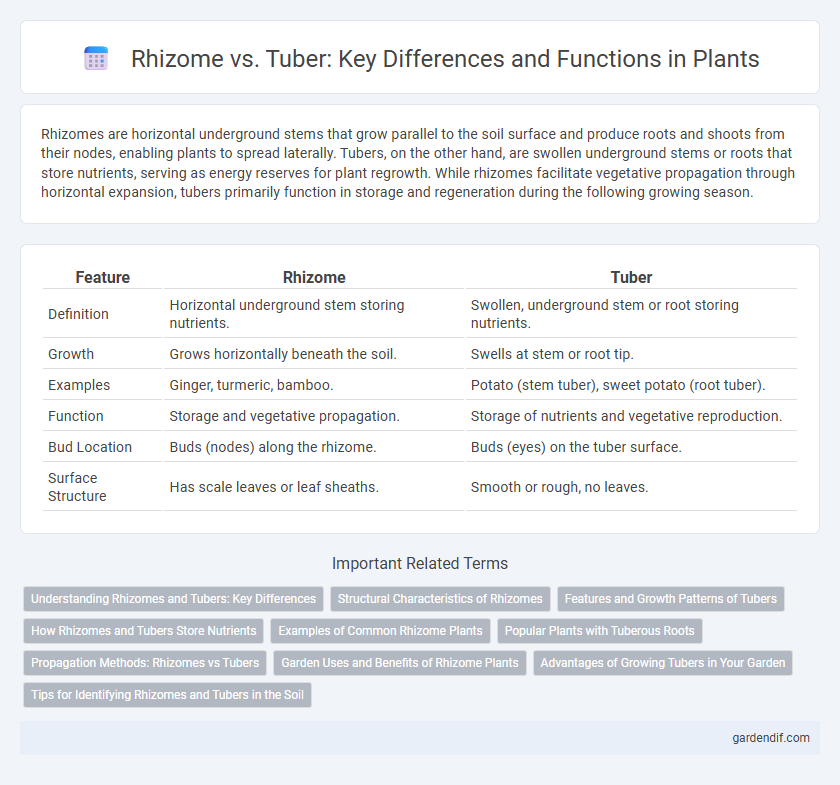
Rhizome vs Tuber Illustration
Rhizomes are horizontal underground stems that grow parallel to the soil surface and produce roots and shoots from their nodes, enabling plants to spread laterally. Tubers, on the other hand, are swollen underground stems or roots that store nutrients, serving as energy reserves for plant regrowth. While rhizomes facilitate vegetative propagation through horizontal expansion, tubers primarily function in storage and regeneration during the following growing season.
Table of Comparison
| Feature | Rhizome | Tuber |
|---|---|---|
| Definition | Horizontal underground stem storing nutrients. | Swollen, underground stem or root storing nutrients. |
| Growth | Grows horizontally beneath the soil. | Swells at stem or root tip. |
| Examples | Ginger, turmeric, bamboo. | Potato (stem tuber), sweet potato (root tuber). |
| Function | Storage and vegetative propagation. | Storage of nutrients and vegetative reproduction. |
| Bud Location | Buds (nodes) along the rhizome. | Buds (eyes) on the tuber surface. |
| Surface Structure | Has scale leaves or leaf sheaths. | Smooth or rough, no leaves. |
Understanding Rhizomes and Tubers: Key Differences
Rhizomes are horizontal underground stems that grow horizontally, producing roots and shoots from their nodes, enabling plants like ginger and turmeric to spread efficiently. Tubers, such as potatoes, are enlarged storage organs formed from thickened rhizomes or stolons, primarily serving as nutrient reservoirs to support new plant growth. Understanding these structural and functional differences highlights rhizomes' role in propagation versus tubers' emphasis on food storage in plant biology.
Structural Characteristics of Rhizomes
Rhizomes are horizontal, underground stems with nodes and internodes that enable vegetative propagation, contrasting with tubers which are swollen storage organs. Rhizomes possess scale-like leaves and buds along their length, allowing new shoots and roots to emerge at each node. Their structure supports rapid spread and resilience in various plant species such as ginger, turmeric, and bamboo.
Features and Growth Patterns of Tubers
Tubers are thickened, fleshy underground stems that store nutrients and enable vegetative reproduction, characterized by the presence of eyes or buds from which new shoots emerge. They grow horizontally beneath the soil surface and develop roots from their undersides, supporting the growth of new plants during the next growing season. In contrast to rhizomes, tubers primarily function as storage organs rather than lateral spreading stems.
How Rhizomes and Tubers Store Nutrients
Rhizomes store nutrients primarily in their underground horizontal stems, accumulating starches and proteins that support plant growth and regeneration during dormant periods. Tubers, such as potatoes, store carbohydrates in swollen underground stems or roots, serving as energy reserves that sustain the plant through unfavorable conditions. Both structures enable perennial plants to survive seasons of dormancy by efficiently reserving essential nutrients.
Examples of Common Rhizome Plants
Common rhizome plants include ginger (Zingiber officinale), turmeric (Curcuma longa), and bamboo species, which spread underground stems for propagation and nutrient storage. Unlike tubers such as potatoes, rhizomes produce roots and shoots along their length, enabling extensive horizontal growth. This structural difference allows rhizomes to efficiently colonize new areas in gardens and natural ecosystems.
Popular Plants with Tuberous Roots
Popular plants with tuberous roots include sweet potatoes, dahlias, and cassava, which store nutrients in enlarged root tissues to survive adverse conditions. These tubers differ from rhizomes, such as ginger and turmeric, which are horizontal underground stems containing nodes and buds. Tuberous roots primarily function as storage organs, while rhizomes facilitate vegetative reproduction and horizontal plant spread.
Propagation Methods: Rhizomes vs Tubers
Rhizomes propagate by producing new shoots and roots from their horizontal underground stems, enabling rapid spread and colonization of an area. Tubers propagate primarily through the growth of buds or "eyes" on their swollen underground storage structures, each capable of developing into a new plant. This difference in propagation methods influences the reproductive efficiency and adaptability of plants like ginger (rhizomes) versus potatoes (tubers).
Garden Uses and Benefits of Rhizome Plants
Rhizomes serve as underground stems that enable rapid vegetative propagation, making them ideal for garden plants such as ginger, turmeric, and iris, which offer both aesthetic and culinary benefits. Unlike tubers that primarily store nutrients, rhizomes promote extensive root growth and soil stabilization, enhancing garden biodiversity and resilience. Their perennial nature supports sustainable landscaping by reducing the need for frequent replanting and improving soil health through organic matter contribution.
Advantages of Growing Tubers in Your Garden
Tubers provide substantial energy storage, enabling plants to survive adverse conditions and regrow vigorously each season, making them ideal for perennial gardening. Their nutrient-rich structure promotes faster sprouting and robust root development, ensuring higher yields and better resilience against pests. Growing tubers in your garden also requires less maintenance compared to rhizomes, as they are less prone to disease and can be easily propagated through simple cutting and planting methods.
Tips for Identifying Rhizomes and Tubers in the Soil
Rhizomes are horizontal underground stems with nodes and internodes, usually covered with thin scales and capable of producing roots and shoots, making them identifiable by their elongated shape and segmented appearance in the soil. Tubers are swollen, fleshy storage structures rich in starch, such as potatoes, characterized by their round or oval shape and presence of "eyes" or buds on the surface. When examining soil, look for rhizomes growing horizontally with visible growth points, while tubers appear as enlarged, nutrient-dense boluses that serve primarily as storage organs.
Rhizome vs Tuber Infographic

 gardendif.com
gardendif.com